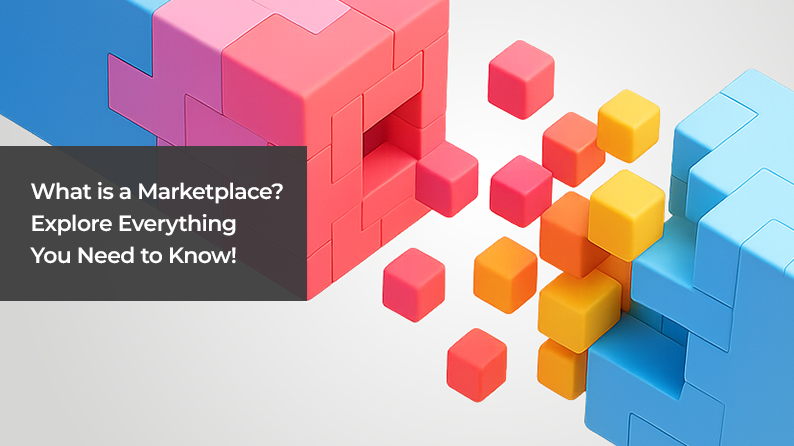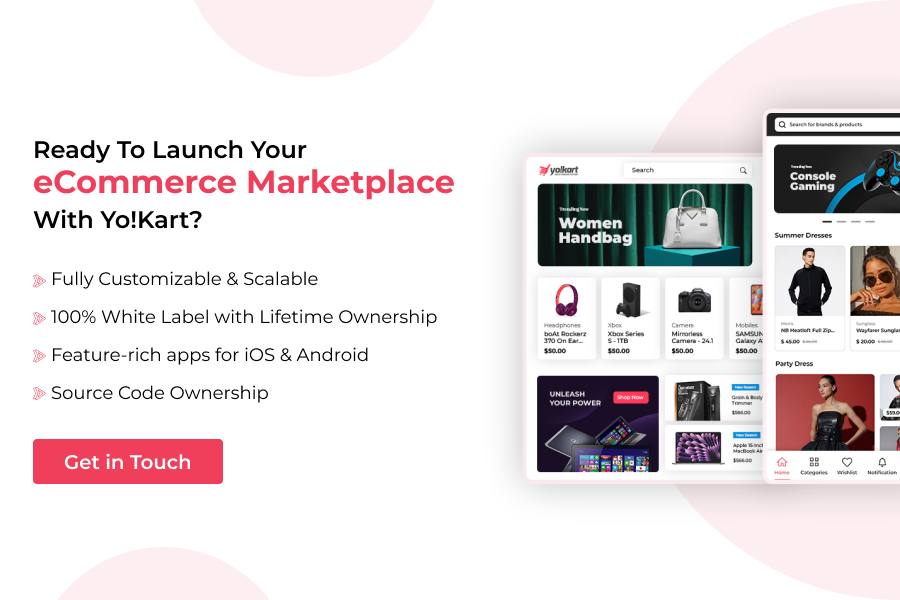What is a Marketplace Platform? Definition, Types, Examples, Benefits, and How to Build
The eCommerce boom has pushed businesses towards digital transformation. The penetration in the US is 27.7% and experts predict the trend will continue globally.
When exploring reasons and critical success drivers, robust marketplaces, emerging technologies and customer shifts have played a significant role. These prominent marketplaces are Amazon, eBay, Alibaba, AliExpress, Etsy, JD.com, Walmart, Shein, and others. They enable buying and selling products online, a phenomenon that is called eCommerce.
According to several research reports by trusted platforms, eCommerce retail sales are expected to reach nearly $ 6.8 trillion in 2025 and are projected to surpass $ 8 trillion by 2027. The eCommerce industry is on the rise. Especially in the past few years, it has grown at a rapid pace and has the potential to reshape the future.
Want to build the next Amazon, eBay, Alibaba or Etsy?
If you are one of those aspiring entrepreneurs looking to build an online marketplace, explore this informative blog first.
This blog will help you understand what an online marketplace is, including definition, types, examples, benefits, challenges, revenue model, how it operates, how to build and more.
Let’s start with “What is an online marketplace”?
Table of Contents
- What is an Online Marketplace?
- What are the Different Types of Marketplaces?
- Top 20 Online Marketplaces Leading the eCommerce Industry
- Difference Between Online Marketplace and eCommerce Store
- Why Build an Online Marketplace?
- What are the Benefits of Building an Online Marketplace?
- What are the Challenges of Building an Online Marketplace?
- Pillars of an Online Marketplace: How Does the Marketplace Model Work?
- Essential Steps: How to Build an Online Marketplace?
- How Can Yo!Kart Help You Build an Online Marketplace?
- Marketplaces Empowered by Yo!Kart
- Launch Your Online Marketplace in Just Four Steps
- Final Thought
- FAQs
What is an Online Marketplace?
An online marketplace works as an intermediary that connects buyers and sellers to buy or sell products by breaking geographical boundaries. What sets an online marketplace apart from the traditional marketplace is its technological innovations, global accessibility, and extensive reach.
The marketplace today has transformed trading. People across the globe connect virtually on a digital platform where two groups interact together, one acts as a buyer and the other acts as a seller. However, user types on a marketplace can be more, such as admin, affiliate, third-party advertiser and others.
Apart from offering convenience, what attracts buyers and sellers to trade online via marketplaces is variety and potential customers. On the one hand, buyers gain access to a variety of products from diverse categories at competitive prices. On the other hand, sellers have access to a wide customer base who are actively looking for products they are interested in.
What are the Different Types of Marketplaces?
Each marketplace harbors unique characteristics, value and experience. Accordingly, they are categorized into different types, which are based on target audience, business model, offerings, scope and more. Take a look at different types of marketplaces below: .
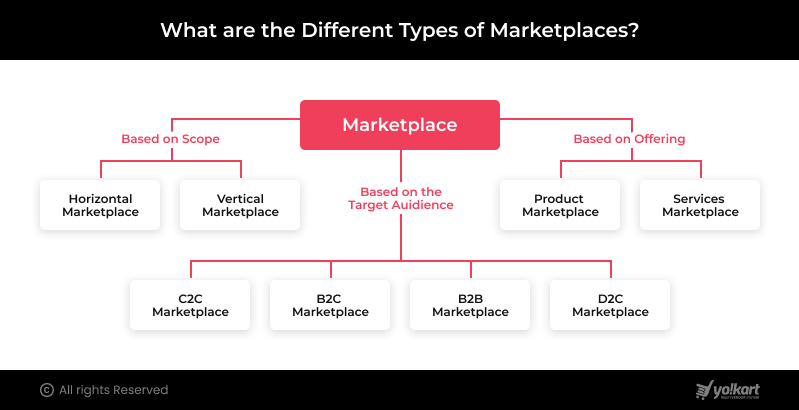
Based on the Business Model or Target Audience:
- B2C (Business-to-Customer) Marketplace: B2C is the most prevalent marketplace type. Multiple sellers or vendors on the platform list their products and buyers, the end users, explore products and make purchases.
In short, on B2C marketplaces, businesses directly interact with potential customers in order to sell products or services.
Example: Amazon, Walmart, eBay
- B2B (Business-to-Business) Marketplace: B2B marketplaces are gaining popularity these days and the sector is growing rapidly due to the convenience and efficiency offered online. However, B2B marketplaces, as the name suggests, offer features and functionalities required to trade between two business entities.
Unlike B2C, on the B2B marketplaces, businesses make purchases in bulk and deal in large volumes. Therefore, several different features and functionalities are needed to ensure seamless B2B transactions.
Example: Alibaba, Amazon Business, Global Sources
- C2C (Customer-to-Customer) Marketplace: Building C2C marketplaces has now become a trend. These types of marketplaces connect two individuals with common interests rather than involving businesses.
C2C, also interchange with P2P (Peer-to-Peer) marketplaces, facilitates options for two individual consumers to buy or sell products or services to each other. The marketplace operates vice versa. Here, a customer can be both a buyer and a seller.
Example: Etsy, Poshmark, Facebook Marketplace
- D2C (Direct-to-Customer) Marketplace: You must have heard about D2C marketplaces. They are not typically multi-vendor. However, they can integrate with third-party vendors, brands or businesses and allow them to sell on their platform, which makes it a multi-vendor marketplace.
Over the last few years, D2C (Direct-to-Customer) has shown good results. According to Statista, clothing, accessories and electronics items are the most sold categories on D2C marketplaces.
D2C marketplace eliminates the need for intermediaries, allowing buyers to make purchases directly from brands. These types of marketplaces help offer their products directly to customers at lower prices to enhance the shopping experience and build brand identity.
Example: Casper, Warby Parker, Glossier
These are the marketplaces that sell their own products but also partner with other brands to expand their product line and offerings.
Based on the Scope:
- Horizontal Marketplace: A Horizontal marketplace is like a one-stop destination for customers. This type of marketplace offers products from different categories and industries such as fashion, electronics, furniture, pharma, home decor, and many more.
These types of marketplaces cater to a broader audience by offering a wide range of products and catering to their specific needs.
Example: Amazon, eBay, Alibaba
- Vertical Marketplace: Vertical marketplaces are focused on a specific niche or industry. Unlike horizontal, they precisely target customers without catering to their broader needs. They help customers find products they are specifically looking for.
With a focus on catering to unique needs, connecting with customers, building strong connections, and offering an enhanced shopping experience, vertical marketplaces target specialized segments and sectors of the market.
Suppose if a marketplace is selling sneakers, then it will only allow sellers to register and list products who are selling sneakers or relevant products.
Example: Esty, Zalando, Airbnb
Based on Offering:
- Product Marketplace: A product-based marketplace enables selling physical and digital products via the platform. It connects buyers and sellers and allows them to buy and sell products based on their needs.
Physical products include everything that we purchase, such as clothing, accessories, furniture, home decor or any other item. In addition, digital products like ebooks, online courses, website themes, graphics, video, software, applications and many others are similar to these.
Example: Amazon, Alibaba, Evanto
- Services Marketplace: A service-based marketplace connects service providers, professionals and experts with customers, meaning users who are looking for those particular services. They provide an option to book services online.
These services can be anything related to home, the tech industry, health, education, travelling, stay and more. You must have heard the names of Uber, Airbnb, Upwork, and more which are known for booking rides, hotels, hiring professionals, etc.
Example: Airbnb, Uber, Fiverr
Marketplaces can also be classified into rental marketplace, global marketplace and more.
Top 20 Online Marketplaces Leading the eCommerce Industry
When you look for the growth drivers in the eCommerce industry, you recall the names of popular marketplaces like Amazon, eBay, Alibaba and Etsy. However, many more marketplaces help the industry keep thriving. Let’s explore the list of the world’s top 20 marketplaces, including their marketplace type, business model, market presence, and monthly visitors:
| Marketplace | Marketplace Type | Business Model | Region Covered | Monthly Visits |
|---|---|---|---|---|
| Amazon | Product & Service | B2C, B2B | Global | 2.8B |
| eBay | Product | C2C, B2C, B2B | Global | 714M |
| Walmart | Product | B2C | US, Canada, Mexico | 580M |
| Alibaba | Product | B2B | Global | 100M |
| Etsy | Product | C2C | US Focused | 400M |
| Taobao | Product | C2C, B2C | China | 303M |
| AliExpress | Product | B2C, B2B | Global | 765M |
| Wayfair | Product | B2C | US | 75M |
| Shopee | Product | C2C, B2C | Asia, Taiwan, Latin America | 500M |
| Rakuten | Product & Service | B2C, B2B, C2C | Japan Focused | 418M |
| Flipkart | Product | B2C | India | 142M |
| JD.com | Product | B2C, B2B | China | 90M |
| Shein | Product | B2C | Global | 230M |
| Zalando | Product | B2C, B2B | Europe | 300M |
| Tmall | Product | B2C | China | 73M |
| Wish | Product | B2C | Global | 2.4M |
| Pinduoduo | Product | C2M | China | 227M |
| Mercado Libre | Product | C2C, B2C | Latin America | 668M |
| Global Sources | Product | B2B | Global | 1.6M |
| Meesho | Product | B2B2C, D2C | India | 30M |
Build an eCommerce Marketplace Similar to Amazon, Etsy and eBay
Difference Between Online Marketplace and eCommerce Store
When it comes to an online marketplace vs an eCommerce store, people often think of what the difference is, which is better, why build a store or a marketplace and more.
However, both an online marketplace and an eCommerce store facilitate online transactions in order to buy and sell products. Yet, they are different in many ways. Let’s explore the clear distinctions between these two.
- Number of Sellers:
On an online marketplace, there are multiple sellers selling products.
On the other hand, in an eCommerce store, only one seller sells the products, which means the business itself is a seller.
- Inventory Management:
Being a marketplace owner, you need to be worried about the inventory; the marketplace doesn’t have inventory itself. The third-party sellers manage the inventory.
However, the inventory on an eCommerce store is managed by the store owner.
- Revenue Streams:
The marketplace can generate revenue via multiple revenue streams, such as commission on each, subscription fees, sponsored ads and featured listing, listing fees, third-party advertising and more.
On the other hand, an eCommerce store primarily generates revenue directly by selling products. In addition, stores can also generate money via subscription, membership and sponsored ads.
- Products Offerings:
Online marketplaces allow a large number of third-party sellers to list and sell their products, catering to a wide range of categories, niches and industries. Marketplace offers a variety of products and services that ultimately attract buyers. Also, sellers gain access to a large customer base.
An eCommerce store, limited by the number, niche or variety of products. They can only offer products for the industry they are catering to.
- Traffic and Market Reach:
Marketplaces often have an established user base. They attract more customers and have more traffic than eCommerce due to a vast product catalog, variety, competitive pricing and more. In addition, different sellers and brands also contribute to driving more traffic according to their own value and customer base.
However, compared to an online multi-vendor marketplace, a single-vendor eCommerce store relies on its own marketing efforts to attract visitors. However, they target customers more precisely and have comparatively higher conversion rates.
Overview of an Online Marketplace vs an eCommerce Store
Explore this comparison table and find what the differences are between an online marketplace and an eCommerce store:
| Feature | Marketplace | eCommerce Store |
|---|---|---|
| Sellers | Multiple | One |
| Revenue | Multiple | Single |
| Inventory | Third-party | Seller-managed |
| Variety | Wide | Limited |
| Quantity | High | Low |
| Traffic | High | Low |
| Fulfilment | Third-party | Owner |
| Model | Diversified | Fixed |
| Focus | Buyers & Sellers | Buyers |
| Investment | Low | High |
| Growth | High | Medium |
| Role | Intermediary | Direct Seller |
| Users | Admin, Buyers, Sellers | Buyers & Seller |
Why Build an Online Multi-Vendor Marketplace?
Let’s not just take action by saying that building an online marketplace is more advantageous. The stats below are more convincing why build an online multi-vendor marketplace instead of an online store.
- 63% online shoppers prefer multi-vendor marketplaces over a single-vendor online store due to convenience, variety, trust and enhanced experience.
- When searching for products, about 47% shoppers visit marketplaces to discover.
- About 75% of the US shoppers want their favourite retailers to interact on marketplaces.
- A significant percentage of customers feel more satisfied when shopping via a multi-vendor marketplace than an online store.
According to the above stats, building a marketplace is more reliable than an online store.
However, let’s make it more visible by helping you understand how becoming a marketplace owner is more advantageous than being a seller through an example:
|
Do you think these marketplaces have their own inventory and sell products by themselves? The answer is NO for most marketplaces, not all. Think of Amazon, a leading online retailer, which has approximately 600 million products listed. What do you think, Amazon sells all its products itself and manages inventory? No! There are more than 9 million sellers on the platform who list and sell their products using the marketplace. However, Amazon has also started selling products itself directly. Of course, marketplace owners can also sell their own products. Amazon works as an intermediary between buyers and sellers and allows them to connect, interact and initiate transactions digitally. It provides an online infrastructure called a marketplace where sellers can list their products, and on the other hand, buyers can make purchases online from available options. What attracts people to become the marketplace owner is that, being a seller, you can only make money by selling your products. On the other hand, a marketplace owner can generate revenue from multiple sources, like Amazon does. These revenue channels include commission, subscription fees, prime membership, sponsored ads, third-party advertisements, and more. However, there are several more reasons to build a multi-vendor marketplace. |
What are the Benefits of Building an Online Marketplace?
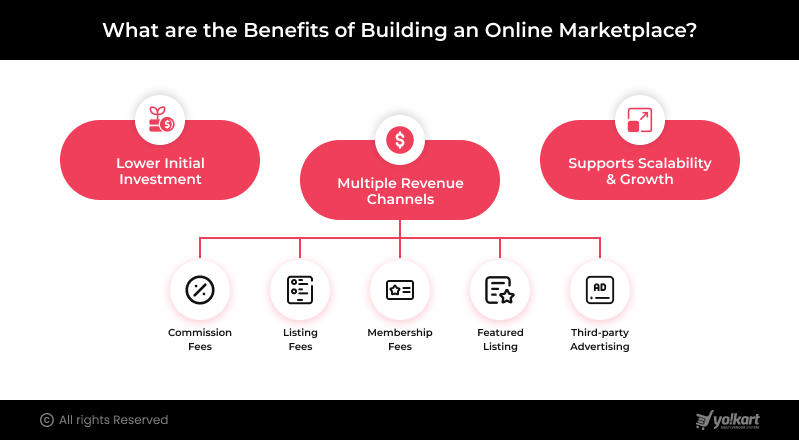
Building an online marketplace brings several benefits. These benefits include a lower initial investment, risk mitigation, a higher chance of growth, multiple revenue streams, and increased scalability. Let’s explore these benefits in more detail.
- Lower Initial Investment:
Building an online marketplace is cost-effective than selling products on your single-vendor store or establishing a brick-and-mortar business.
When you sell products on a single-vendor eCommerce store requires higher upfront costs to own and manage inventory due to managing inventory, warehouse, logistics, shipping and other overhead costs.
However, starting an online marketplace only requires initial setup and platform cost. It can also be minimized by building a marketplace using readymade marketplace software and applying several strategies.
Build Your Own Multi-Vendor Marketplace Starting at $499
- Supports Scalability and Growth:
Scalability and growth potential are the key highlights. Marketplaces can be scaled rapidly by onboarding more sellers and attracting more customers by offering a variety of products.
In short, the ability to onboard third-party sellers, expand product lines and diversify offerings enables marketplaces to expand and grow faster than an online store.
- Multiple Revenue Channels:
Marketplaces offer financial stability through a diversified revenue stream. You can generate revenue via multiple revenue streams.
How Do Marketplaces Make Money?
- Commission: The marketplace charges a certain percentage or a fixed amount on each sale or transaction initiated on the platform when buying or selling products as a commission fee. Typically, commission is paid by the seller.
Commission on sale or each transaction is the most common revenue generation strategy for marketplaces.
- Listing Fees: Sellers pay a certain amount in order to list products on the marketplace as a listing fee. It can be a flat fee or a percentage of the final price or even a combination of both.
Etsy, a popular C2C marketplace, charges a flat percentage of 0.20% for each listing.
However, most of the marketplaces allow sellers to list their products for free up to a certain number of listings.
- Subscription/Membership Fees: Marketplaces charge a certain amount monthly, quarterly or yearly as a subscription fee to allow access to some premium features, tools and offerings.
Talking about Amazon, it charges subscription fees on different levels to provide free shipping, video streaming, ad-free music and more for buyers or users looking for premium services.
Here’s a breakdown:
- Annual Prime: $139
- Monthly Prime: $14.99
- Prime Shopping Edition: $14.99/Month
Amazon also charges a monthly fee of $39.99 to sellers selling more than a certain number. However, those don’t charge for membership; they pay $0.99 on each sale as a referral fee.
- Featured Listing and Ads: Marketplaces charge fees from the sellers on the platform to increase visibility in search results and on the homepage of their product listed, called feature listings or sponsored ads.
These strategies increase the chances of products being sold to customers as they find them at the top of their search results and pages they interact with.
- Third-party Advertising: In a third-party advertisement, a marketplace allows businesses other than the marketplace to promote their products or services within the marketplace via banner image and any other medium. In return, businesses pay certain charges to the marketplace. That’s how the marketplace generates revenue via third-party advertisement.
What are the Challenges of Building an Online Marketplace?
Building an online marketplace is an exciting experience. At the same time, it brings several challenges. Therefore, you need to be prepared to face and overcome them. Let’s discuss a few major challenges that a marketplace owner can encounter.

- Idea Validation:
There are no such parameters or specific methods to decide whether your business idea is successful or can fail. You can’t go with perspectives and predictions.
However, several strategies through which you can validate your idea and analyze whether it will work or not, and of course, predict the chances of success.
You can conduct market research, analyze competitors, find gaps, understand the customer’s needs and perform more such activities. In addition, once you are done with the market research and analysis, in the next step, you can launch your marketplace MVP (Minimum Viable Product) before introducing a full-fledged marketplace.
Launching an MVP is the most accepted method to validate an idea at a lower expense and risk.
- Chicken-Egg Problem:
Whom to attract first? Seller or Buyer?
For marketplace marketers, it’s been difficult to determine whether they should target sellers first or buyers. If there is no supply, the buyer will not be interested. On the other hand, if there is no demand, sellers will not take an interest.
However, according to several studies and marketplaces, the challenge has been solved. The answer to the question is to attract sellers first. There are several reasons behind this conclusion.
The first is, if businesses find growth opportunities, they can wait, but buyers don’t.
Secondly, marketplaces can attract sellers by offering free listings, lower commission percentage, less transactional charges and more. However, attracting buyers without inventory and supply is tough, nearly impossible.
- Market Competition:
The eCommerce industry is evolving every day. Marketplace competition is on the rise. A large number of entrepreneurs, startups, and existing businesses are stepping into the eCommerce industry by building their online marketplaces. Therefore, the competition is really tight.
No one wants to be left behind. Neither your competitors nor you. Each one of them is fighting to be ahead of the competition. Approaching innovative ideas, following strategies and trends, improving customers’ experience and doing much more. That’s the spark that keeps you motivated to do so in order to drive success and achieve goals.
Tips to beat competition:
- Build trust and develop a sense of security among customers by implementing various security measures and applying several branding strategies.
- Understand the interests of your targeted customers and plan further marketing strategies accordingly.
- Highlight your USPs and UVPs when marketing, as it will help you attract customers and build brand identity.
- Keep up with the times by following trends and demand.
- Customer service matters the most; it helps you retain customers and improve overall marketplace experience. Therefore, focus on building strong relationships with customers via support and services.
Launch a Fully Customizable and Scalable Multi-Vendor Marketplace
Pillars of an Online Marketplace: How Does the Marketplace Model Work?
The concept of the marketplace operates behind the three main pillars. These pillars are the marketplace Admins (owner/operator), sellers and buyers. Each of these participants play their role to make the platform fully operational and accessible. Let’s explore how:
- Role of the Marketplace Administrator
The marketplace admin is the first pillar of the marketplace who acts as the operator. Firstly, they launch the platform and provide the infrastructure required.
The marketplace operator means the admin can assign multiple sub-admins who are responsible for functioning and managing the operations on the platform. In addition, they ensure a balance between supply and demand on the online marketplace.
Marketplace admins onboard buyers, attract sellers, set rules, policies, ensure security, build trust, facilitate options to initiate transactions, provide customer service, handle promotional activities, analyze data, plan strategies, and monitor overall performance, growth opportunities, and other aspects.
- Role of the Marketplace Seller
The marketplace seller is the second pillar of the online marketplace, who helps the marketplace operator to maintain the supply chain to fulfill the demands of the buyers.
There can be multiple sellers on the marketplace who can list and sell products to the customers according to their business interests. For them, the marketplace acts as an intermediary to connect with buyers. On the other hand, sellers on the platform help the marketplace build a vast catalogue from diverse categories and industries.
- Role of the Marketplace Buyer
The third pillar of the marketplace, the buyer around whom the entire marketplace works and operates. They accelerate demand and the supply chain works for them. In short, the marketplace operator and the seller implement all possible strategies to attract more and more buyers on the platform.
Buyers are like the end users who search, explore and make purchases by making payments. A marketplace buyer can be an individual or a business that will either use the products themselves or want to resell them.
Essential Steps: How to Build an Online Marketplace?
Building an online marketplace is an exciting adventure for entrepreneurs and business owners. However, it requires proper planning and execution to drive growth and success.
In this section, we will discuss the essential steps to follow when building an online marketplace.
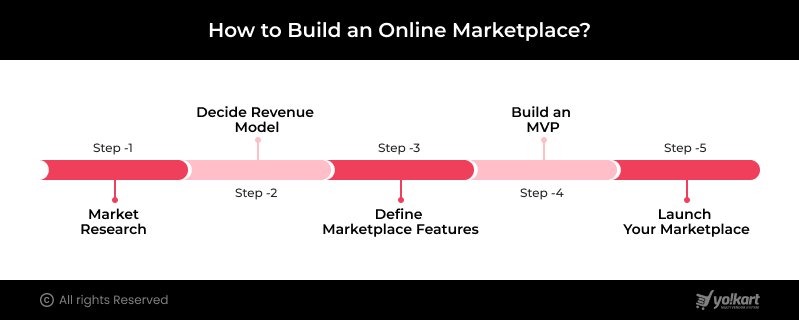
Step 1: Market Research and Idea Validation
When building an online marketplace, the first step one should start the journey with is to conduct thorough market research. Doing market research helps you find the following:
- Competitor Analysis: When analyzing competitors, you can find gaps or unresolved issues that you can resolve by launching your marketplace.
- Opportunities: You can identify the new and untouched opportunities.
- Target Audience: When you build a marketplace, it is crucial to decide the target audience. While doing market research, you will be able to choose your platform type based on the target, such as B2C, B2B, C2C, or any other.
- Demand: You will find the areas, sectors, niche or category that you can target.
- Customer Behaviour: You can understand the characteristics, needs, and preferences of your target audience.
- Idea Validation: Market research helps in deciding the genuine demand for products or services you are going to offer. In short, you can validate your idea and rework or reframe if you find it is not thriving.
- Informed Decision: At the end, you can make further decisions based on data, insights and analysis.
- Define Budget: Market research also helps you define an estimate of the budget. Accordingly, you can allocate your budget or plan further.
Step 2: Decide Revenue Model
Once you finalized the essential features for your marketplace. Now it’s time to decide your revenue channels. It helps you outline how your business will operate, generate revenue and make a profit.
- Commission: The most prevalent revenue model, marketplaces charge a flat fee or a percentage of the final selling amount to generate revenue.
- Subscription Fees: In this revenue model, the marketplaces charge monthly, quarterly, or yearly fees to provide access to the premium services.
- Listing Fees: Marketplaces charge a fee to sellers to list products.
- Featured Listing: Online marketplaces allow sellers to increase visibility of their product or catalog via sponsored or paid ads, another revenue generation channel for the marketplace.
- Third-party Advertisement: Marketplaces can generate revenue by allowing businesses to promote their products or services on the platform.
Step 3: Define the Marketplace Features
Once you have finalized the market research, got answers to all your questions and decided to launch your online marketplace. In the second step, you need to define marketplace requirements, including features, functionality and technology.
Below essential features are required to operate an online marketplace:
Features for Buyers:
- User Login and Sign Up
- Advanced Search and Filter
- Add to Cart
- Multiple Payment Gateway
- Easy Checkout
- Direct Messaging
- Order tracking
- Customer Support
Features for Sellers:
- Seller registration & profile management
- Listing Management
- Order Management
- Analytics and Reporting
- Promotional Tools
- Messaging with Buyers
- Import/Export
Features for Admin:
- Vendor Management
- Commission Management
- Reporting and Analytics
- Order Management
- Marketing and SEO tools
- Content Management
- Logistic Management
- Payment and Refund
- Catalog Management
Step 4: Build an MVP (Minimum Viable Product)
Plan and build an MVP before launching a full-fledged product in the market
An MVP is the basic version of your marketplace with essential features. It is introduced to the early adopters in order to gather feedback and improve the areas.
A minimum viable product is a preferred option for entrepreneurs and startups to validate their marketplace idea with minimal risk and cost.
Benefits of Launching an MVP:
- Validate Ideas
- Reduced Development Cost
- Faster Time-to-Market
- Less Risky
- Chance to Improve Product
- Provides Feedback from Early Adopters
- Attract Investors
How to Build an MVP?
There are two popular ways to build a marketplace MVP:
1. Custom Development: You can build your marketplace MVP by developing it from scratch, which requires more time, resources and expenditure.
2. Readymade Software: You can build an MVP by choosing a readymade software that offers similar control and ownership as building a marketplace from the ground up. In addition, this type of software helps you minimize time and spend required when developing from scratch.
Build an MVP Using Self-Hosted Software
Step 5: Launch Your Full-Fledged Marketplace:
After launching your marketplace MVP, once you are satisfied with the further feedback, updates and validation. Now it’s time to complete further development and introduce your full-fledged marketplace.
After launching your marketplace, start promotion, onboarding maximum sellers you can, attract buyers through several offers, discounts, coupons and other perks.
How Can Yo!Kart Help You Build an Online Marketplace?
Yo!Kar is a readymade software that allows you to launch your online marketplace. Entrepreneurs always prefer this readymade solution when it comes to finding a feature-rich solution. However, apart from being feature-rich, Yo!Kart is cost-effective, self-hosted, easily scalable, fully customizable and a 100% white label marketplace software that also makes the software an ideal one.
If you are also one of those entrepreneurs, startups or business owners looking to step into this ever-growing eCommerce industry by launching your own multi-vendor marketplace, you can choose Yo!Kart as your forever partner.
The software is available at a one-time payment option that eliminates paying monthly, quarterly or yearly recurring charges. Moreover, with Yo!Kart, you also own the source code that ultimately provides complete control and ownership over the marketplace.
Marketplaces Empowered by Yo!Kart
Yo!Kart is a trusted multi-vendor marketplace partner for entrepreneurs, startups and existing businesses in over 70 countries. The software has empowered 5500+ marketplaces. Let’s explore a few marketplaces launched with Yo!Kart:
- Voyij:
A marketplace based in the USA, especially launched for connecting travellers in Alaska with local businesses, hotels and other services to empower businesses and enhance the experience for travellers. View Case Study
- Kilakitu:
Kilakitu is based in Burundi, provides a platform for consumers to access and order a wide range of multi-category products online and get them delivered to their doorsteps.
- Watersorted:
This B2B marketplace focuses on water management, connecting businesses in New Zealand with suppliers for various water systems in order to deal with escalating water pollution challenges. View Case Study
- UNI Diamond:
This is a B2B marketplace specifically for the diamond industry, allowing buyers and sellers to trade polished diamonds. View Case Study
- NPK Marketplace:
A US-based multi-vendor marketplace for sustainable products such as fertilizers. The marketplace connects growers, gardeners, landscapers and other professionals with livestock farmers to provide organic, NPK-certified fertilizers.
Launch Your Online Marketplace in Just Four Steps
With Yo!Kart, you can launch your marketplace effortlessly. The team behind the software helps you launch your platform in just 4 easy steps without going through a lengthy development process.
Step 1: Get Your License
Yo!Kart offers different packages. You can choose the package that suits your marketplace requirements and get a lifetime license for use.
Step 2: Set-up & Installation
We provide free installation of Yo!Kart on your preferred server. Our experts connect and help you with the setup and installation.
Step 3: Onboard Sellers
Once the software is installed on your server, you can customize the platform, onboard sellers to list products and do much more.
Step 4: Launch and Manage
In the fourth step, after the completion of all three above steps, you can launch, manage, and grow your full-fledged marketplace easily.
Build a thriving online marketplace with Yo!Kart
Final Thought
Thanks for reading this blog. Hope you found this informative and insightful and you have got answers and resolutions to all your queries and concerns you were looking for.
Online marketplaces have revolutionized the eCommerce industry. Whether an individual wants to buy products or book services, marketplaces are making it possible in just a few clicks. The most attractive part is, customers worldwide are preferring shopping online.
In addition, the technological advancements, convenience, variety, growth opportunity, scalability and more are growth drivers to the marketplaces.
For entrepreneurs and startups looking to kick-start their eCommerce journey, it’s a good time to build an online marketplace. If you are interested in building an online marketplace, you can start your marketplace journey with Yo!Kart, a readymade marketplace software that can meet all your needs and help you build a thriving eCommerce platform.
FAQs
Q 1. How much does it cost to build an online marketplace?
Ans. Launching an online marketplace can cost you anywhere between $499 $100000 or even more. You can see a huge difference between the prices; it depends on your development approach and selection.
Building an Online marketplace from scratch can cost $30000 to $100000 or more. However, launching an online marketplace using a readymade software like Kart can start at $499.
Q 2. How can I ensure data security on my marketplace?
Ans. To ensure data security on your marketplace, you can encrypt data at rest and in transit, implement multi-factor, keep your software up-to-date, conduct regular security audits and more.
Q 3. What are the benefits of building an online marketplace compared to a brick-and-mortar marketplace?
Ans. Building an online marketplace is always beneficial than a brick-and-mortar marketplace. Let’s check them out:
- Lower initial investment
- No physical space needed
- You can reach a wider audience
- Easily scalable with growing business needs
- Reduced overhead costs
- Provides an opportunity to operate a business globally
- Easy to manage than a traditional marketplace
- Help you build brand image
- Provides multiple revenue streams
There are several more benefits of operating an online marketplace.
Q 4. How to attract buyers and sellers on the marketplace?
Ans. You can plan several strategies to attract buyers and sellers on the marketplace:
To Attract Sellers:
- Easy onboarding
- Free Listing
- Lower commission
- Lower or zero transaction fees
- Robust dashboard
- Attractive Offerings like free advertisement, promotional package and more.
To Attract Buyers:
- Variety of Products
- Vast catalog
- Competitive Pricing
- Offers and Discounts
- Referral Incentives
- Enhanced UX/UI
In addition, you can promote your marketplace on multiple platforms, including social media and run marketing campaigns, where you can find and interact with sellers and buyers.
